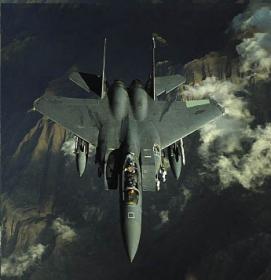 The design of electronic systems for aerospace applications shares many of the same constraints as apply to consumer products – e.g., cost (including NRE), power dissipation, size, time-to-market. Both market segments are driven to leverage the integration benefits of process scaling.
The design of electronic systems for aerospace applications shares many of the same constraints as apply to consumer products – e.g., cost (including NRE), power dissipation, size, time-to-market. Both market segments are driven to leverage the integration benefits of process scaling.
Additionally, there are unique characteristics to avionics:
- the total volume of the shipped product is (relatively) small
For example, the ubiquitous Boeing 737 family has shipped a cumulative total of ~10K aircraft.
- the product lifetime is measured in decades
The longevity of aerospace systems requires focus on part reliability (often operating at extreme temperatures). And, very significantly, the long product lifetime implies that upgrades to technical requirements and ongoing enhancements will need to be addressed – in other words, the avionics may need to be “re-missioned”. Yet, any physical modification to a Line Replacement Unit in the avionics requires qualification and re-certification of the entire aircraft system.
- for (some) avionics applications, there are requirements to utilize sourcing from a “trusted foundry”
These characteristics have led to the pervasive adoption of FPGA’s in avionics design, in both new aircraft and in retrofit equipment for existing aircraft. FPGA’s are used throughout current avionics:
- the primary flight computer
- the navigation system and radar
- (heads-up) cockpit displays
- the braking system
- engine controls
- cabin temperature and pressure control, lighting
As an illustration of the rapid adoption of FPGA’s, the avionics in the Mars Exploration Rover (circa 2003) incorporated a very high percentage of ASIC’s – for the Mars Science Laboratory (circa 2011), that percentage has flipped to the use of FPGA’s.
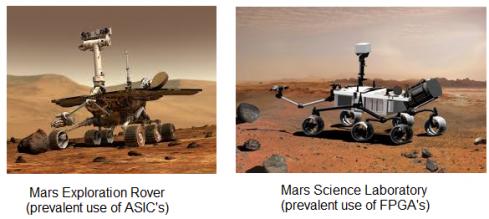
Another development of specific note is the broad adoption of software and hardware standards for all avionics systems, namely DO-178B and DO-254 (see the figure below).
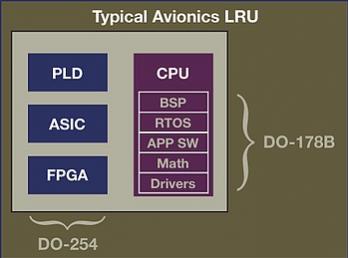
(From: Hilderman,“DO-178B and DO-254”, http://mil-embedded.com/articles/do-178b-do-254-unified-aerospace-field-theory/ )
The DO-254 standard defined the requirements for the tools (and documentation), bitstream configuration, and implementation testing flows in support of FPGA integration in avionics hardware systems.
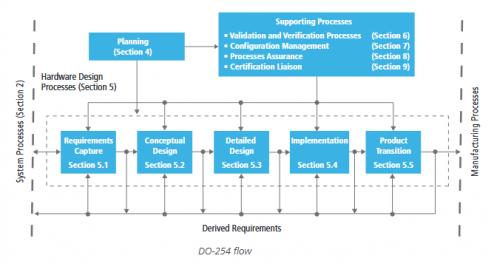
In short, FPGA’s are an efficient implementation for the signal processing of streaming data and control systems prevalent in avionics. Further, the reconfigurability of the FPGA logic implementation greatly simplifies the introduction of system updates – with no physical changes required, the logic and software design is the only facet of the revision that need re-certification.
Speaking of Boeing, a press release recently crossed the wire that piqued my interest: “Boeing Defense, Space & Security Licenses Flex Logix’s Embedded Field-Programmable Gate Array on GLOBALFOUNDRIES 14nm Process”. (link)
As (COTS) FPGA’s have seen rapid adoption in avionics, it makes sense that the emerging embedded FPGA technology would be an ideal fit. I reached out to Geoff Tate, CEO of Flex Logix, about the press release and the future opportunities for eFPGA IP in avionics design.
Geoff confirmed the current overall FPGA adoption with some compelling statistics, “Currently, about 30% of the IC content of aerospace system electronics is (commercial) FPGA’s. Avionics represents approximately 10% of the commercial FPGA market revenue.”
There is a price premium for these parts, as they are characterized and qualified over a greater temperature range. Depending upon the target application (and the logic redundancy features included in the design implementation), the commercial FPGA’s may also leverage radiation-hardened circuitry.
I asked Geoff, “What are the advantages of an embedded FPGA in avionics?”
“Avionics design requires extreme focus on size and power – taking advantage of the benefits of technology scaling is extremely important. Cost is certainly a critical consideration, as well. Embedded FPGA’s enable SoC integration in advanced process nodes. SoC integration also helps to address the computational throughput requirements, which are as demanding as high-performance networking and commercial applications.”, Geoff replied.
“What are the characteristics of the eFPGA designs that you are reviewing with customers?”, I inquired.
Geoff answered, “Avionics systems are seeking rather large embedded FPGA logic arrays – e.g., >100K LUT’s. We are working with customers to review their existing designs(with commercial FPGA’s). Typically, a significant percentage of their system design allocated to an FPGA part does not need reconfigurability. As we discuss SoC integration, there is an opportunity to re-partition their system into optimized hard-wired SoC logic, directing only the reconfigurable functionality to the embedded FPGA IP.”
Geoff continued, “Our eFPGA tile (LUT and configuration)architecture enables us to integration a rad-hard cell library, if the avionics application requires. We have previously collaborated with DARPA (on an older process node) to provide silicon and an evaluation board utilizing a rad-hard library – that collaboration was certainly a catalyst for aerospace customers to pursue embedded FPGA IP at advanced nodes.”
“Sourcing for aerospace designs is a key concern – can you briefly describe the partnership with GLOBALFOUNDRIES?”, I asked.
Geoff replied,“GF has been extremely supportive throughout. We worked with Boeing to identify the GF 14LPP fabrication capabilities in Malta NY as a match to their requirements. We developed the eFLX tile utilizing both the GF standard cell library, merged with unique (eFPGA-optimized MUX and FF) cells developed here at Flex Logix utilizing the GF 14LPP PDK. With the updated eFPGA tile, the GF14LPP testsite utilized the existing design methodology – the same eFLX compiler, the same extraction and delay calculation flow, the same multi-corner static timing analysis flow.”
The prototype GF 14LPP eFPGA silicon will be validated by Flex Logix in 1Q’19, with customer validation boards available in mid’19. Silicon validation will include investigating low VDD operation (e.g., VDD_min = 0.5V).
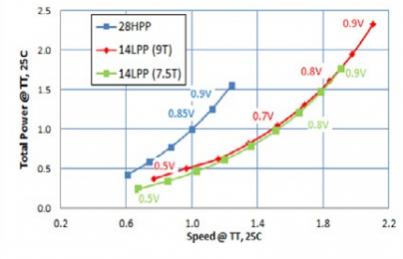
(from: https://www.globalfoundries.com/sites/default/files/product-briefs/pb-14lpp.pdf )
Avionics system design reflects the same trends as other performance-driven market segments – namely, a need to address power, size and cost constraints through process scaling and SoC integration. Additionally, the requirement to support design re-configurability is key. As Geoff summarized our conversation,“We are experiencing a significant increase in the design pipeline from the aerospace segment.” Embedded FPGA IP will no doubt be a key facet in future avionics architectures.
-chipguy
Share this post via:





Comments
There are no comments yet.
You must register or log in to view/post comments.